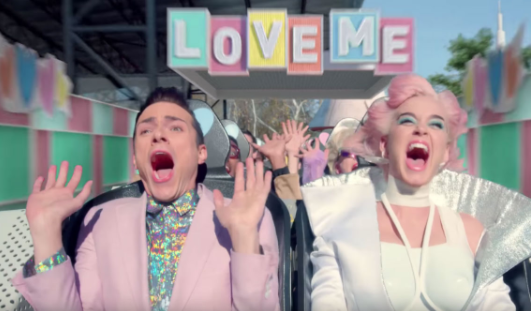After Katy Perry’s first live performance of the initial single, “Chained to the Rhythm,” from her fourth album (fifth, if you actually want to count Katy Hudson) at the highly polarizing Grammy Awards, it was pretty clear she wasn’t going to stop her recent cashing in on chicest moment in time to be political. And though her message is salient, it can be at times, a little too tailored to the Trump constituency in terms of hitting one over the head with overt “symbolism.” Like naming the theme park she attends Oblivia, for example.
The corresponding opening lyrics, “Are we crazy? Living our lives through a lens/Trapped in our white picket fence like ornaments/So comfortable, so comfortable, we’re livin’ in a bubble,” fit with the cookie cutter mold of the theme park, the ultimate representation for human distraction in America–an all-encompassing embodiment for phones, computers, social media, et. al.
Directed by Mathew Cullen (who also did Perry’s “Dark Horse” video), the saturated-in-color aesthetic is in keeping with Perry’s usual Teenage Dream tones, however, this time, it manages to fit in neatly with her commitment to “purposeful pop.” For instance, take a ride on the American Dream Drop to get a brief taste of what was most important in the United States in the 1950s: buying a home (or rather, buying a mortgage to a home) and getting married. Or, if that’s not your cup of tea, you can also ride the Love Me roller coaster or take a drink of some Molotov-like liquid at the Inferno H20. Better yet, why not ride the hamster wheel for humans? You’re already doing it metaphorically anyway.
Yet it’s this obviousness in emphasizing that the American dream is housing a latent nightmare beneath it, and that we’ve all been too dazzled by our coma to acknowledge it–hence, the rise of the Trump administration like a more darkly-hued mushroom cloud–that makes “Chained to the Rhythm” somewhat lacking in the originality it would like to believe it has. After all, let’s not forget about Grace Jones’ similarly titled, “Slave to the Rhythm,” released in 1985 and featuring the lyrics, “Work all day, as men who know/ Wheels must turn to keep, to keep the flow/Build on up, don’t break the chain.” It’s a little subtler than: “Turn it up, it’s your favorite song/Dance, dance, dance to the distortion/Turn it up, keep it on repeat/Stumbling around like a wasted zombie.” But then, Perry is catering to a slightly dafter audience than Jones was.



















